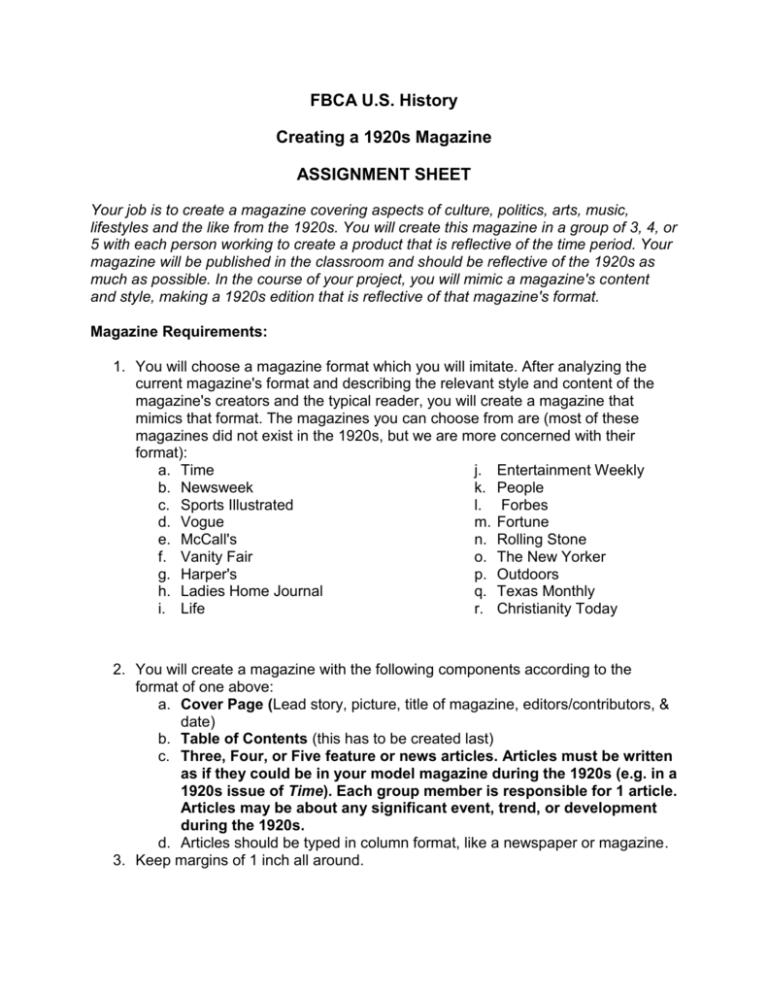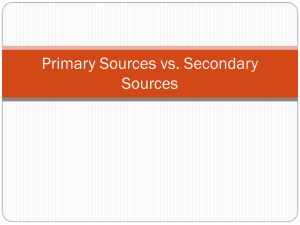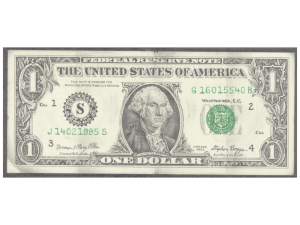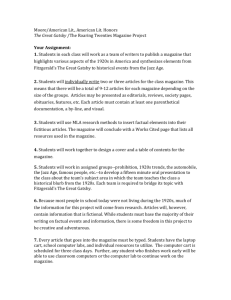1920s Magazine Project
advertisement

FBCA U.S. History Creating a 1920s Magazine ASSIGNMENT SHEET Your job is to create a magazine covering aspects of culture, politics, arts, music, lifestyles and the like from the 1920s. You will create this magazine in a group of 3, 4, or 5 with each person working to create a product that is reflective of the time period. Your magazine will be published in the classroom and should be reflective of the 1920s as much as possible. In the course of your project, you will mimic a magazine's content and style, making a 1920s edition that is reflective of that magazine's format. Magazine Requirements: 1. You will choose a magazine format which you will imitate. After analyzing the current magazine's format and describing the relevant style and content of the magazine's creators and the typical reader, you will create a magazine that mimics that format. The magazines you can choose from are (most of these magazines did not exist in the 1920s, but we are more concerned with their format): a. Time j. Entertainment Weekly b. Newsweek k. People c. Sports Illustrated l. Forbes d. Vogue m. Fortune e. McCall's n. Rolling Stone f. Vanity Fair o. The New Yorker g. Harper's p. Outdoors h. Ladies Home Journal q. Texas Monthly i. Life r. Christianity Today 2. You will create a magazine with the following components according to the format of one above: a. Cover Page (Lead story, picture, title of magazine, editors/contributors, & date) b. Table of Contents (this has to be created last) c. Three, Four, or Five feature or news articles. Articles must be written as if they could be in your model magazine during the 1920s (e.g. in a 1920s issue of Time). Each group member is responsible for 1 article. Articles may be about any significant event, trend, or development during the 1920s. d. Articles should be typed in column format, like a newspaper or magazine. 3. Keep margins of 1 inch all around. 4. The page on which your article is written should be in magazine format; that is, no large expanses of blank paper. You might wrap the article around a picture or an advertisement. 5. Your articles must correspond to the date of your magazine and have some perspective of time. For instance, if your magazine is written in 1927, you cannot write about the stock market crash of 1929, and any articles about Babe Ruth must either be about the glorious 1927 season or retrospectives about his still vibrant career. 6. BIBLIOGRAPHY: Include a properly formatted bibliography at the end of your article. For each article, you must use at least two sources of information. (You do NOT need to cite sources in the text of the article.) 7. Besides the article, you will add supplementary pieces to the magazine. Each two group member is responsible for of the following. You may not have more than two of each type in the magazine (These items should be original creations – not a print out from a CD-ROM or a copy of an advertisement you have seen in your research. They should combine your historical knowledge with your imagination. Each should be tailored to your magazine's audience). Note: The Editor and Cover Artist will be responsible for one of the supplementals. a. A graphic (map, chart, etc. with contextual explanation of at least 150 words) b. Advertisement (by private organizations or the government). You may copy images but you must create the text yourself. The ads must suit the audience of the magazine and be a popular product of the era. c. Letter to the Editor - on a current (to the period) controversial issue d. Political Cartoon (must be created, not copied) 8. Turn in a “Grading Guideline” for each student which has both the student author's name and the title of his articles on it. Grading Standards and Due Dates General Guidelines/Expectations: Content: 1. Accuracy in reporting. 2. Accounts that are rich in detail, factual evidence, and that are interesting to read. The person who reads your magazine should learn much about the era! 3. Each group member will fulfill his/her responsibility Style: 1. Imagination and creativity, both in writing and presentation 2. Well-written articles including proper grammar and spelling. Use rich details in a logical order. 3. A neat, professional, aesthetically pleasing magazine that is consistent with the model magazine you have chosen. If I were from the target audience would I pick it off the shelf in the 1920s? Point Values: 100 points total for each person 50 points for your news/ feature article: Graded on quality of research, writing and analysis. Items must be appropriate to time period and interesting to read. Article must fit the style of the magazine type chosen (Time, People etc.) 20 points for each supplementary piece (40 total): Quality of artwork or writing essential. Appropriate analysis of 1920's should be evident in piece. Pieces must fit the style of the magazine type chosen. 10 points for overall group/magazine grade: How well do the articles fit together? Does the magazine feel like an issue of Vogue or Time? Do the cover and table of contents give a good sense of the magazine? Due Dates: Due Tuesday Nov 9: Preliminary ad analysis: IN CLASS. Choose an ad from the magazine you brought to class. Analyze its content to determine the target audience of this magazine. Homework: Examine websites for ideas of topics for your magazine. Choose your topic and decide which supplemental items you will do. Due Wednesday, November 10: IN CLASS. Magazine Analysis + Group Selection: Form groups for project. Pick magazine. Analyze the target audience by looking at ads, letters to editor, table of contents. Analyze magazine for conservative or liberal leanings. Decide who will be the editor and who will design the cover for your magazine. Fill out the sheet with topics of articles, authors, and supplemental items. Magazine analysis due at end of period. Homework: Conduct research and take notes for your article and supplemental items. Due Friday, November 12: Sheet for proposed feature article. Homework: WRITE YOUR ARTICLE FOR Tuesday. Due Monday, November 15: Sheet for proposed supplementals. Due Tuesday, November 16: Article due. In-class editing and critique with group members. Homework: Revise your article and research supplemental pieces. Due Wednesday, November 17: Bring research for supplementals, including cover. In class draft supplementals/cover. Critique within group. Homework: Revise and prepare for publication. Due Thursday, November 18: All final completed articles and supplements due in. Hard copies are required. NO EMAILING! Editor will check that all components are complete. He/She will type a table of contents and assemble the magazine. Each student will fill out his/her Grading Rubric with titles of articles/supplements. Artist will create cover of magazine. Friday, November 19: Assembled magazine due at the beginning of class. Grading Rubric – 1920's Magazine Project Student Name_____________ Feature Article Title:________________ Supplementary Piece #1 Title:_______________ Supplementary Piece #2 Title:_______________ News/Feature Article: Research quality and analysis of historical data: 10 15 20 25 30 Quality of writing – appropriate style, grammar, spelling: 2 4 6 8 10 Magazine fits the type chosen (Time, etc.): 1 2 3 4 5 Bibliography included: 0 or 5 Point Value = 50 Score: ________________ Supplementary Pieces (graphic, ad, letter to editor or political cartoon, cover, contents page): Research quality, analysis of historical data, and relevance of piece: 3 5 8 10 Quality of writing/visual ( – appropriate style + grammar/spelling 1 2 3 4 5 Content fits the type of magazine chosen (Time, etc.) 1 2 3 Bibliography included: 0 or 2 Point Value = 20 each Score #1: _____ Score #2: ________ Total Supplemental: _______ Group Grade: Overall quality of writing, research, presentation and organization. 3 5 8 10 Point Value = 10 Score: ________________ Your total score _________________ Step One: Tuesday, November 9 Name: ____________________ Ad and Magazine Analysis As preparation for your creation of a 1929s magazine, today you will analyze the magazine you have chosen to imitate. Using one of the ads included in your magazine, you will write an analytical paragraph in which you describe the TARGET AUDIENCE of the magazine. Consider and include as many of the following components as possible: 1. The age range of the target audience 2. The economic group targeted 3. The lifestyle of the group targeted 4. Anything you can tell about the values or major concerns of the group targeted FORMAT: one extended paragraph with a clear topic sentence establishing the purpose of the paragraph and with specific details of the ad (text and picture) that led you to your conclusions about the audience Evaluation Criteria: Excellent Adequate Needs work Missing Topic Sentence Text Details And Analysis Photo Details And Analysis Mechanics EVALUATION: CLICK HERE FOR A SAMPLE: http://www.howhist.com/sample.htm Step 2: Wednesday, Nov. 10 MAGAZINE ANALYSIS Magazines usually have a target audience. Of course, they would like to sell to as many people as possible, but since no magazine can be all things to all people, they will usually target a group large enough to make a profit, but specific enough to be distinctive. Try to figure out what the magazine’s target audience is. You will do this by looking at the type of ads, departments, articles, and, if available, reader responses such as "Letters to the Editor." In this analysis of the audience, consider such factors as: the education level required to read the articles the hobbies or interests of the audience the political slant (conservative or liberal) the economic class of the reader You can get hints to these by analyzing: the products advertised (Tide or Godiva Chocolates?) the depth of the articles (superficial, in-depth) the level of vocabulary the tone (lighthearted, serious) the emphasis in the coverage of a particular newsworthy event (politics, business, fashion, behavior) It is often helpful to compare two magazines in the same field (Vogue vs. Cosmopolitan, Time vs. Newsweek, Rolling Stone vs Vanity Fair) to fine-tune your answers. NAME OF MAGAZINE_______________ Group Members: Describe the general category of magazine. (What are the majority of the articles about?) 1. Soci-economic class of the typical reader __________________ How can you tell?: Educational level of the typical reader ________________ Age and gender of reader_____________________ Lifestyle and Occupation of reader___________________ 2. Emphasis of articles What is concentrated upon in a given news/article event? Is the slant conservative or liberal? __________ How can you tell? Below, in one complex sentence, describe the profile of the targeted reader, including all of the information above. PROPOSED FEATURE ARTICLE AND SLANT Author's name (that's you)_______________________________ Topic of your feature article_______________________________ The magazine you will be imitating___________________________ Briefly explain what “spin” or angle you plan to take with your topic in order to make it fit the type of magazine you are creating: Example: TOPIC: Model T Ford FOR VOGUE MAGAZINE: Since Vogue tries to appeal to the status-conscious independent woman, I will write about how owning an automobile will increases their power and prestige. I will give some background on the car, have pictures of “classy” car models, and reveal the impact the car has on a woman's lifestyle. PROPOSED FEATURE ARTICLE AND SLANT Author's name (that's you)_______________________________ Topic of your feature article_______________________________ The magazine you will be imitating___________________________ Briefly explain what “spin” or angle you plan to take with your topic in order to make it fit the type of magazine you are creating: Example: TOPIC: Model T Ford FOR VOGUE MAGAZINE: Since Vogue tries to appeal to the status-conscious independent woman, I will write about how owning an automobile will increases their power and prestige. I will give some background on the car, have pictures of “classy” car models, and reveal the impact the car has on a woman's lifestyle. PROPOSED Supplemental Items Author's name (that's you)_______________________________ The magazine you will be imitating:___________________________ Type of supplemental for #1 (circle one): Editorial Cartoon Advertisement Letter to Editor Editor/Contents Graphic Cover Page Topic of your supplemental #1: _________________________________ Type of supplemental for #2 (circle one): Editorial Cartoon Letter to Editor Graphic Advertisement Topic of your supplemental #2: _________________________________ PROPOSED Supplemental Items Author's name (that's you)_______________________________ The magazine you will be imitating:___________________________ Type of supplemental for #1 (circle one): Editorial Cartoon Advertisement Letter to Editor Editor/Contents Graphic Cover Page Topic of your supplemental #1: _________________________________ Type of supplemental for #2 (circle one): Editorial Cartoon Letter to Editor Topic of your supplemental #2: _________________________________ Graphic Advertisement Step Three: Your next task is to research the era to decide what articles and supplementary pieces you will create for your magazine that will adequately reflect the era and your magazine's style. A. View at least two of the general sites below for an overview of the events and personalities of the era: Excellent site with coverage of 1920s. Digital History project from University of Houston: http://www.digitalhistory.uh.edu/database/subtitles.cfm?TitleID=67 Great overview of the era with specific events in various fields (science, sports, etc.): http://library.thinkquest.org/C005846/The_1920/the1920.htm?tqskip1=1&tqtime=1017 Political Timeline http://www.infoplease.com/ipa/A0005247.html A real magazine from the twenties, St. Nicolas Magazine will give you an idea of the drawings and subject matter of a popular magazine from the era. http://www.english.uwaterloo.ca/courses/engl208c/1920.htm#StNick%20mag B. Below are some more narrowly-focused sites for special topics. Info about the actress Clara Bow, good for fashion and movies. http://www.clarabow.net/ Art Deco Art and Architecture. http://www.decopix.com/About_Art_Deco_Architecture/ Info about Louise Brooks, actress. Good source for fashion and movies. http://www.pandorasbox.com/ Sports: http://library.thinkquest.org/C005846/categories/sports/sports.htm Flappers: http://history1900s.about.com/od/1920s/a/flappers.htm Interior Décor, good info for advertisements: http://www.bassocantante.com/flapper/decor.html Jazz in the 1920s: http://www.pbs.org/jazz/time/time_roaring.htm Music and Dancing in the 1920s: http://www.bassocantante.com/flapper/music.html Temperance movement, prohibition, speakeasies: http://www.legendsofamerica.com/ahprohibitionspeakeasy.html Fascinating article about two Texas Baptist pastors in the 1920s, J. Frank Norris & Truett: http://www.preaching.com/resources/past-masters/11625552/ Info on 1920s radio and music: http://www.southernmusic.net/1920.htm Politics in the 1920s: http://us.history.wisc.edu/hist102/lectures/lecture17.html Google. And there’s always Step 4: Write the article. Step 5: Write your two ads, letters to the editor, graphics (with 150 word explanation) editorial cartoons. Step 6: Editor edits, All revise Step 7: Turn in all articles & supplements. Step 8: Editor edits and assembles. Step 9: Turn in final magazine. Check due date list. Failure to bring assignments on time will result in a penalty. 1920s Magazine Project Ideas and Sources Major Events, Trends and Ideas from the 1920s: Consumer and Popular Culture: Americans begin the trend of spending for what one wants in addition to what one needs. Rise of advertising, mass media (including radio and consolidation of newspapers) and cheaply produced goods create a change in spending. The automobile was especially important and became the backbone of American economy through the 1970s. Time and Reader's Digest magazines were founded and others such as the Saturday Evening Post were popularized. Prohibition goes into effect in 1920, causing widespread crime and a whole culture of speakeasies, bathtub gin, and gangsters. Al Capone and Bugsy Moran make their mark. Women's role in society is rapidly changing: A second large feminist movement emerges with women gaining suffrage in 1919 and styles/practices of women both in leisure and work start changing. In fashion “Flappers” emerge. Women begin drinking & smoking in public. More women also enter the workforce. Birth control is widely advocated for the first time by Margaret Sanger. “Joe College” a popular image drawn by William Held. Harlem Renaissance: A new arts movement flourishes in New York. Its influence spreads to and comes from the South, Chicago, Kansas City. Artists like Langston Hughes, Zora Neale Hurston, Marcus Garvey, Claude McKay, Dorothy West, Jean Toomer, Paul Robeson and Cab Calloway were among the stars. Jazz – America's Classical Music: American music started to come into its own, with a character that was distinct from European or African influence. Major players included Duke Ellington, Louis Armstrong, Kid Ory, and Bessie Smith. Politics – Return to Normalcy: A labor movement was strong through the early 1920's and tied to Socialist elements. Later a “Red Scare” coupled with nativism caused the ousting of Socialist leaders and immigrants. President Harding and his V.P. (who later became president) asked for a return to “normalcy”. The scandals of the Harding administration further shook the confidence of people in government. Urbanism: More and more people moved to the cities, creating new interactions. 1920 was the first census in which more Americans lived in urban areas than rural areas. Sports: Baseball, Tennis, Golf, Football, and Boxing each gained new popularity. Stars included Babe Ruth (baseball), Jack Dempsey (boxing), Red Grange (football). Helen Wills (tennis), and Bobby Jones (golf). The 1927 Yankees are considered by many as the greatest American sports team ever. Movies: Charlie Chaplin, Mary Pickford, Rudolph Valentino and Clara Bow were stars of this popular art form. Silent films gave way to talkies in the 1920s. Literature: F. Scott Fitzgerald (The Great Gatsby), Ernest Hemingway (The Sun Also Rises and A Farewell to Arms), T.S. Eliot (The Wasteland), Edna St Vincent Millay (poetry) and Sinclair Lewis (Main Street) were notable authors of the time. Nativism/Immigration: The Ku Klux Klan reached its highest membership during the 20's. Several Congressmen and government administrators were members, and the organization found large numbers of new recruits. New immigration laws were passed to keep out Southern and Eastern Europeans and select Asian groups. Religion: How were people’s religious views changing? What were the main movements within Christianity? Who were the prominent preachers, churches, etc? Possible Research Sources Books: 1. Your textbook – nice summaries and beginning point. The timeline on pg. 428 may provide a starting point. 2. Allen, Frederick Lewis. Only Yesterday : This is generally considered the best source of scholarship about the time period. Most other historians make at least some reference to it. 3. Evans, Harold. The American Century: A nice summary of the century with some interesting subtopics on the 1920s. 4. Freidel, Frank & Alan Brinkley. America in the Twentieth Century: Another nice summary book on the century with good writing on the 20s. Consumer culture section especially good. 5. Carter, Paul. Another Part of the Twenties: About social attitudes in the 1920s. 6. Sann, Paul. The Lawless Decade: Wonderful photographs and short excerpts about news topics in the era. Not so good on race issues, but excellent coverage of gangland issues and prohibition. 7. Clark, Norman. Deliver us from Evil: Examines prohibition. 8. Chalmers, David. Hooded Americanism: Examines the KKK 9. Boorstin, Daniel. The Americans: The Democratic Experience: Another excellent general US history book with a nice section on the 1920s. 10. Zinn, Howard. A People's History of the United States: The standard alternative view of American History. Zinn looks at the underbelly of American society – large coverage of socialist movements. Reference Sources: In the reference section, also look at the books filed under “E”. Ask the reference librarian. There are several excellent encyclopedias and general histories here with wonderful articles about the 1920s. Examples include: 11. Encyclopedia of Social History. 12. Encyclopedias of American Culture (not sure of the name, but there are several under this category) 13. Look to the Reader's Guide of Periodical Literature for magazine articles about the 1920's. American Heritage magazine runs good articles regularly.







